Disclosure: This article contains affiliate links. We may earn a commission from purchases at no extra cost to you, which helps our travel content.
Standing at the crossroads of Dotonbori, where centuries-old culinary traditions collide with hyper-modern neon spectacle, I found myself mesmerized by the architectural dialogue playing out above the crowds. Osaka after dark isn't merely a setting for nightlife—it's a masterclass in temporary space design, where light itself becomes a building material and social interactions shape environments as much as concrete and steel. After twenty years analyzing luxury hospitality spaces, I've found few urban environments that speak to the relationship between design and human experience quite like Osaka's nocturnal landscape.
Dotonbori: Where Architectural Spectacle Meets Culinary Theater
Dotonbori's famed canal district represents perhaps the world's most fascinating study in vertical spatial design. Unlike the horizontal sprawl of most entertainment districts, Osaka's premier nightlife zone builds upward in a chaotic yet somehow harmonious stack of signage, terraces, and illuminated facades that create a canyon-like effect.
On my third evening in Osaka this fall, I positioned myself at the Ebisubashi Bridge just as the sun set, watching the transformation from commercial corridor to luminous playground. The famous Glico Man sign—unchanged in basic form since 1935 yet constantly modernized in technology—serves as an architectural anchor point around which the entire district's visual identity revolves.
What fascinates me most is how the buildings themselves become secondary to their illuminated skins. Traditional Japanese architectural principles of negative space and balanced asymmetry somehow survive in this seemingly chaotic environment, creating framed vignettes as you navigate the crowded streets. For capturing this sensory overload, I found my DJI Osmo Mobile 7p invaluable for shooting stabilized video while walking, allowing me to create smooth tracking shots that captured both the vertical scale and horizontal movement of the district.

💡 Pro Tips
- Visit Dotonbori between 7-9pm when the lights are on but crowds are still manageable
- The Ebisu-bashi Bridge offers the best vantage point for photography of the iconic Glico Man sign
- Look up! The most interesting architectural details are often above eye level
Architectural Nightcaps: Osaka's Design-Forward Bars
Beyond the sensory overload of Dotonbori lies a more subdued yet equally fascinating nightlife scene where architectural principles drive the drinking experience. In Osaka's upscale bar districts, I've found spaces that challenge conventional Western notions of what constitutes a "bar" through their innovative use of materials, lighting, and spatial flow.
In Kitashinchi, the financial district that transforms into an upscale playground after dark, I discovered Bar Compass—a minimalist marvel tucked into a 1970s office building. The establishment employs what I call "architectural compression and release," with a narrow, dimly lit entrance corridor that suddenly opens into a soaring two-story space dominated by a backlit liquor wall. The bartenders work at a counter made from a single slab of 300-year-old hinoki cypress, illuminated by custom pendant lights that create pools of warm light in an otherwise shadowy space.
For those seeking something more intimate, the warren-like alleys of Temma conceal tiny standing bars where design elements are distilled to their essence. At Tachinomi Kikuya, the entire establishment is smaller than most American walk-in closets, yet the thoughtful material palette of copper, aged wood, and washi paper creates a space that feels both ancient and timeless. I recommend bringing a pocket flashlight to navigate these dimly-lit alleyways—the best architectural treasures are often hidden in the darkest corners.

💡 Pro Tips
- Make reservations for high-end bars in Kitashinchi at least 2-3 days in advance
- In standing bars, position yourself where you can observe the bartender's craft—often the central design element of these spaces
- Most design-forward bars open around 7pm but don't get lively until after 9pm
Osaka's Ephemeral Design: Pop-Up Spaces and Temporary Installations
What truly distinguishes Osaka's nightlife from other global cities is its embrace of impermanence—a concept deeply rooted in Japanese aesthetic traditions like wabi-sabi. Throughout my week exploring the city after dark, I encountered numerous temporary spaces that exist for mere weeks or months, yet are executed with the design precision of permanent establishments.
In America Village (Amerikamura), I stumbled upon a vacant lot transformed into an open-air natural wine bar constructed entirely from shipping pallets, canvas, and string lights. The space, called Nomad Wine Garden, will exist for just three months before being dismantled. Yet its designers created a sophisticated flow of spaces with varying degrees of privacy and social interaction opportunities through nothing more than thoughtful arrangement of simple materials.
For those interested in documenting these fleeting architectural moments, I recommend bringing a portable tripod for low-light photography. My favorite discovery was an abandoned subway station entrance in Nakazakicho that hosts a different pop-up concept each weekend—from cocktail bars to listening rooms for vinyl enthusiasts. The organizers use portable LED light panels to completely transform the concrete infrastructure into warm, inviting spaces that belie their utilitarian origins.
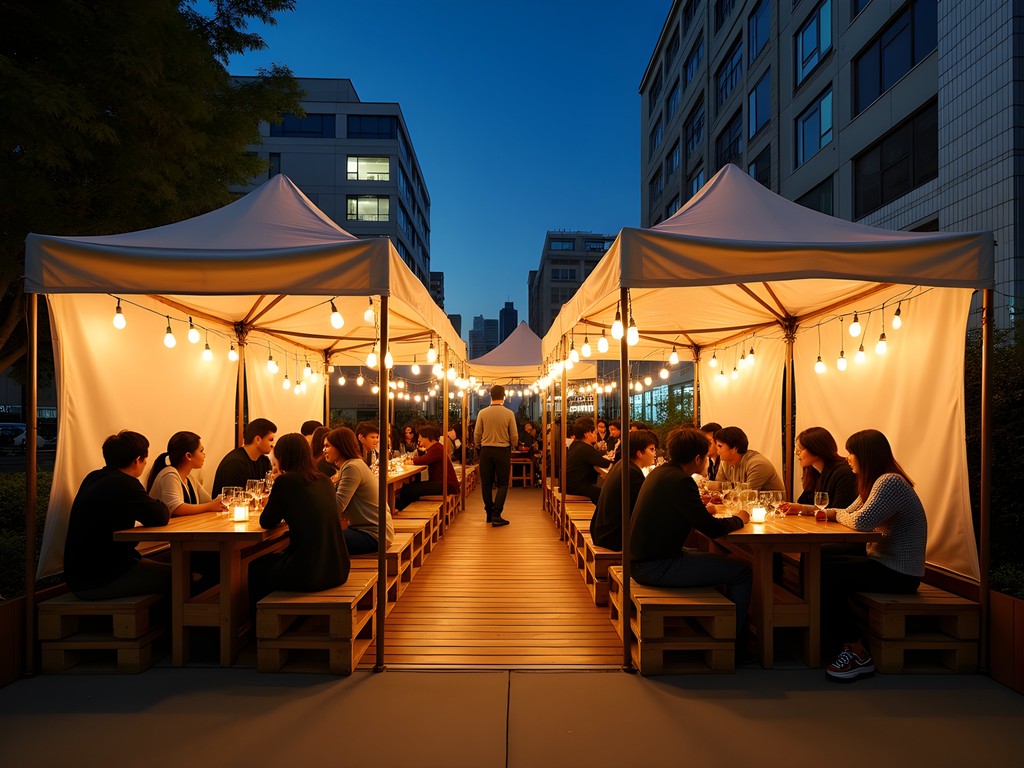
💡 Pro Tips
- Follow Instagram accounts like @osaka_popup and @night_osaka for up-to-date information on temporary installations
- Visit Nakazakicho on Friday and Saturday nights when most pop-ups are operating
- Don't be deterred by language barriers—most pop-up spaces welcome curious visitors
Sonic Architecture: Osaka's Underground Music Venues
No exploration of Osaka after dark would be complete without examining how sound shapes space in the city's legendary music venues. Unlike Tokyo's clinically perfect listening rooms, Osaka embraces a rougher, more industrial approach to acoustic design that reflects the city's working-class roots.
In Amerikamura, Noon+Café operates as a coffee shop by day but transforms into one of Asia's most respected experimental music venues by night. The owners have approached acoustics as an architectural element, with custom-designed sound diffusers doubling as decorative ceiling elements and strategically placed absorptive materials concealed within what appear to be sculptural wall installations. Even the seating—low platforms covered in tatami—serves acoustic functions by minimizing reflective surfaces.
For those sensitive to sustained loud volumes, I suggest bringing high-fidelity earplugs that reduce volume without distorting sound quality. During my visit to legendary techno bunker Circus, these proved invaluable for appreciating the venue's remarkable sound design without fatigue.
The most architecturally significant venue I discovered was Triangle, housed in a converted concrete warehouse in the port district. The owners preserved the industrial shell but inserted a series of floating wooden platforms at various heights, creating acoustic separation between different zones while maintaining visual connections across the space. The result is a venue where one can experience music from multiple perspectives—both sonically and spatially.

💡 Pro Tips
- Most serious music venues don't get active until after 11pm, with peak hours between 1-3am
- Triangle requires advance tickets for weekend events, available through their website
- Look for venues with tiered or multi-level designs that allow you to experience the acoustics from different positions
After Hours: The Architecture of Dawn
Perhaps my most profound architectural experience in Osaka came not at the height of nightlife but in its gradual dissolution into morning. After a full night exploring venues across the city, I found myself at Tsuruhashi Station as the first trains began running around 5am. Here, I witnessed what I can only describe as the architecture of transition—spaces designed specifically for this liminal time between night and day.
The 24-hour Kissa Yoron café near the station has operated continuously since 1965, serving strong coffee and light meals to nightlife denizens heading home and early workers starting their day. The interior remains unchanged since the 1960s, with wood-paneled walls darkened by decades of cigarette smoke and booth seating arranged to create both privacy and community. What struck me most was how the space seemed designed specifically for this threshold time—neither fully night nor day—with lighting that somehow flattered both the exhausted reveler and the fresh-faced commuter.
For capturing these transitional moments between Osaka's night and day, I relied on my DJI Osmo Mobile 7p to create time-lapse sequences showing how the city's architecture transforms as dawn breaks. The stabilization allowed me to set up extended shots that captured the subtle shift in how buildings present themselves as natural light gradually replaces artificial illumination.
Nearby, Tsuruhashi Market begins stirring around this time, with food stalls preparing for the day in spaces that, just hours earlier, hosted late-night drinking establishments. The architectural flexibility of these modest structures—many little more than corrugated metal shells with roll-up doors—speaks to Osaka's pragmatic approach to space utilization.

💡 Pro Tips
- The first trains start running around 5am—perfect timing to witness the city's transition from night to day
- Kissa Yoron café welcomes both night owls and early birds, with no judgment for which category you fall into
- For photographers, the 'blue hour' just before sunrise offers the perfect balance of artificial and natural light for urban architecture shots
Final Thoughts
Osaka after dark reveals itself not merely as a playground for pleasure-seekers but as a laboratory for experimental approaches to space, light, and social interaction. Unlike the carefully curated nightlife districts of Tokyo or the preserved historical environments of Kyoto, Osaka embraces a certain productive chaos—allowing pop-up venues to colonize unexpected spaces, encouraging architectural innovation through impermanence, and preserving idiosyncratic establishments that would likely be renovated out of existence in more image-conscious cities.
What continues to draw me back to Osaka's nocturnal landscape is precisely this tension between the ephemeral and the enduring. In an era where global cities increasingly resemble one another, Osaka maintains a distinctly local architectural vocabulary after dark—one that speaks to both its mercantile history and its working-class identity. For couples seeking more than mere entertainment but a genuine window into how design shapes experience, Osaka's neon nights offer lessons that extend far beyond Japan. The city demonstrates how nightlife spaces, often dismissed as frivolous or temporary, actually serve as vital testing grounds for architectural ideas that eventually influence our more permanent environments. In Osaka, the night is not merely when the city plays—it's when the city innovates.
✨ Key Takeaways
- Osaka's nightlife architecture emphasizes vertical space unlike the horizontal sprawl of most entertainment districts
- The city embraces impermanence through sophisticated pop-up spaces and temporary installations
- Traditional Japanese design principles survive even in the most contemporary nightlife environments
- Dawn reveals a unique 'architecture of transition' where night and day overlap in both function and clientele
📋 Practical Information
Best Time to Visit
Fall (September-November)
Budget Estimate
$100-200 per night for couples
Recommended Duration
5-7 nights
Difficulty Level
Intermediate
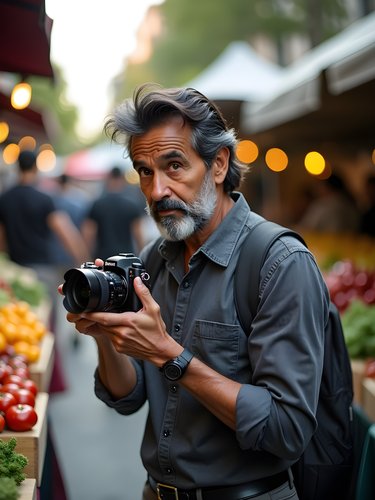

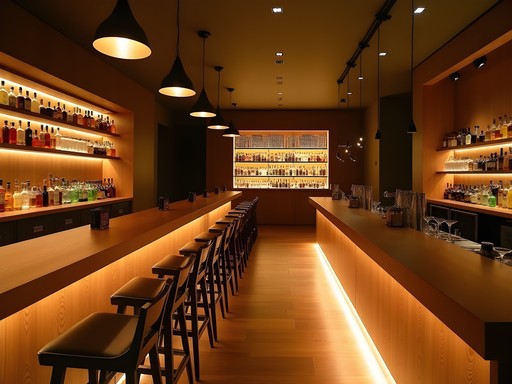





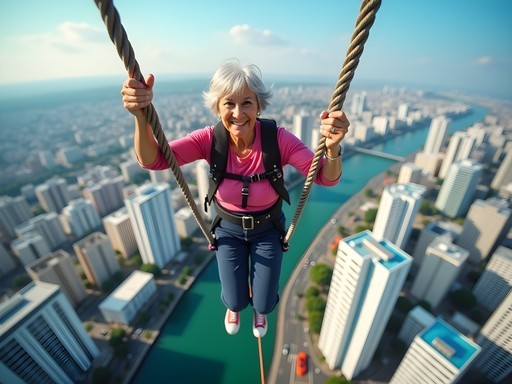
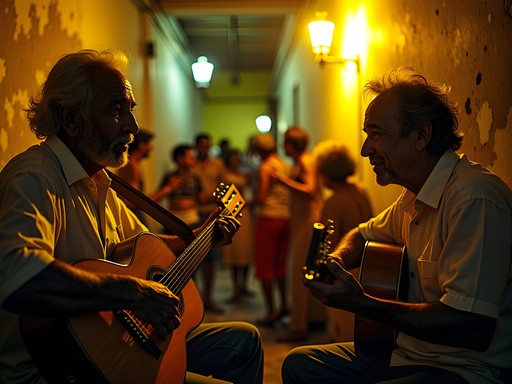
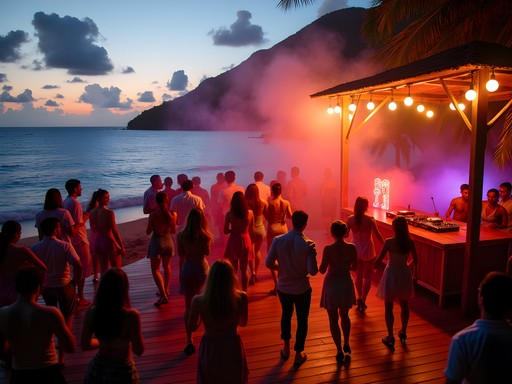
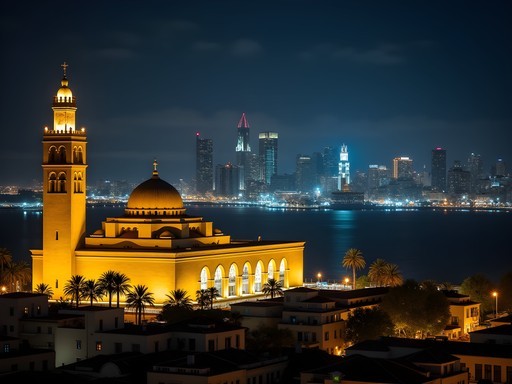
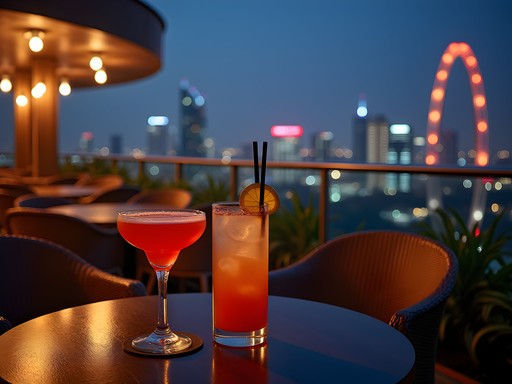
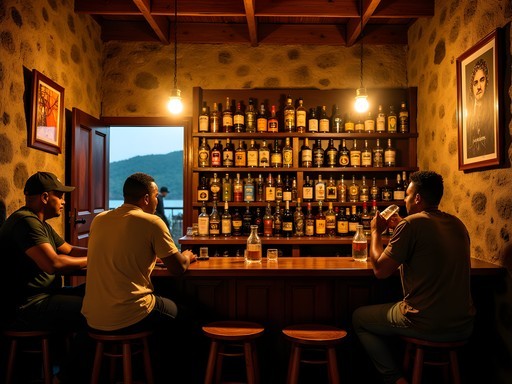
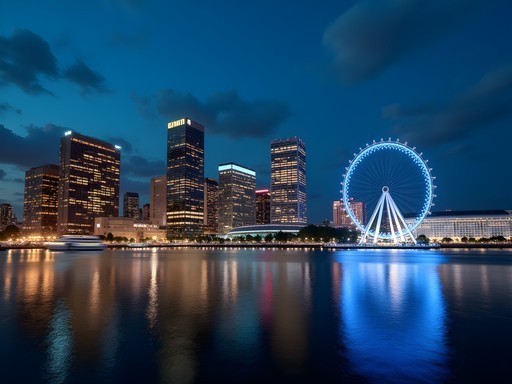
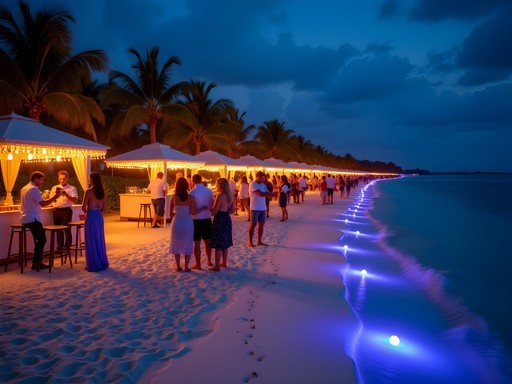
Comments
Jean Wells
Excellent analysis of Osaka's architectural contrasts, Raj. Having lived in Yokohama for 12 years, I've witnessed how Osaka's nightlife spaces have evolved in ways distinctly different from Tokyo. What fascinates me most is how the underground music venues you mentioned - particularly those in converted industrial spaces in Shinsekai - represent a form of architectural recycling that's uniquely Osakan. The pragmatic approach to space utilization while maintaining historical elements creates environments that feel simultaneously raw and curated. Did you happen to visit any of the temporary sound installations that pop up in the abandoned shopping arcades near Tennoji? They're ephemeral but extraordinary examples of sonic architecture.
nightowl_92
Those sound installations near Tennoji are incredible! Caught one last year that used the acoustics of an old bathhouse. Magical experience.
wanderlust_emma
Just got back from Osaka and used Lonely Planet Osaka City Guide to find some of these underground venues. The map section for Shinsekai was super helpful!
smartking
Great post but surprised you didn't mention the building height restrictions that shape Osaka's unique skyline! That's what makes the night view so special - it's spread out horizontally rather than vertically like Tokyo. The 3D neon signs compensate for the lack of tall buildings. My favorite spot was that rooftop bar in Umeda where you can see the whole basin lit up. Spent way too much on drinks but the view was worth every yen!
coffeeace
Just got back from Osaka last week and this post makes me want to return immediately! The architectural contrast between day and night is incredible. We stumbled into one of those temporary installations you mentioned - a light garden inside what looked like an abandoned warehouse. Completely transformed the space! My tip: don't overplan your night route. The best experiences came from following random side streets when something caught our eye.
moonstar
Was it scary wandering random streets at night? Going next month and a bit nervous about getting lost!
coffeeace
Not at all! Osaka feels super safe even late at night. Just keep Google Maps handy and you'll be fine. The city grid is actually pretty navigable once you get used to it.
tripphotographer
That shot of the Glico Man reflection in the canal is stunning! What camera setup did you use?
roamlife
This looks amazing! I'm planning my first solo trip to Japan next spring and Osaka is definitely on my list. How safe is it to explore these nightlife areas alone? Any specific spots I should avoid?
Jean Wells
Osaka's nightlife areas are generally very safe, even for solo travelers. I've wandered Dotonbori alone countless times over the years. Just use standard travel precautions. The only area that might feel intimidating is Tobita Shinchi, but that's not mentioned in this article anyway.
roamlife
Thanks Jean! That's reassuring to hear. Any must-visit spots for someone who loves architecture but isn't big on crowded clubs?
Jean Wells
Check out the 'Architectural Nightcaps' section Raj mentioned - those design-forward bars tend to be more intimate. Bar Nayuta in particular has stunning minimalist design and isn't usually overcrowded. Also consider visiting Dotonbori earlier in the evening to appreciate the architectural elements before the late-night crowds arrive.
Hunter Thompson
YESSS! Osaka's night scene is ABSOLUTELY WILD! Crashed there for nearly a month last year and the architectural contrasts blew my mind! Those pop-up spaces you mentioned near Shinsaibashi were hosting this insane projection mapping event when I was there - literally felt like I was walking through digital dimensions while completely sober (well, mostly sober 😂). Pro tip for anyone heading there: don't miss the tiny underground jazz bars in America-mura! They're tucked away in basements that look sketchy but open into these mind-blowing intimate venues. I recorded some ambient sounds there for my travel podcast and they're still my most downloaded episode! Bring a decent pocket translator though - the best spots are where English menus don't exist!
journeylife
How late do those underground music venues stay open? Planning a trip in January and wondering about timing.
roamhero
Most run until 5am, especially on weekends. Triangle in Amerikamura sometimes goes even later for special events!
roamhero
Been to Osaka 3 times and still haven't seen half these spots! Saving this for my next trip.
Taylor Moreau
Excellent breakdown of Osaka's architectural nightscape, Raj. I've been traveling to Osaka quarterly for business since 2023, and your analysis of how the traditional and hypermodern elements interact is spot on. Those design-forward bars you mentioned in the Nakazakicho area have become my go-to for client meetings - they perfectly balance impressive aesthetics with private conversation spaces. The way ambient lighting is used to create distinct zones without physical barriers is something I haven't seen executed as well elsewhere in Asia.
journeylife
Taylor, any specific bar recommendations for someone visiting Osaka for the first time? Something impressive but not too overwhelming?
Taylor Moreau
I'd recommend Bar Nayuta for first-timers - minimalist design with spectacular lighting and excellent whisky selection. Not too crowded on weeknights.
moonstar
Those Dotonbori neon lights are insane! Your photos really capture the energy!
Venture X
Premium card with 2X miles, $300 travel credit, Priority Pass